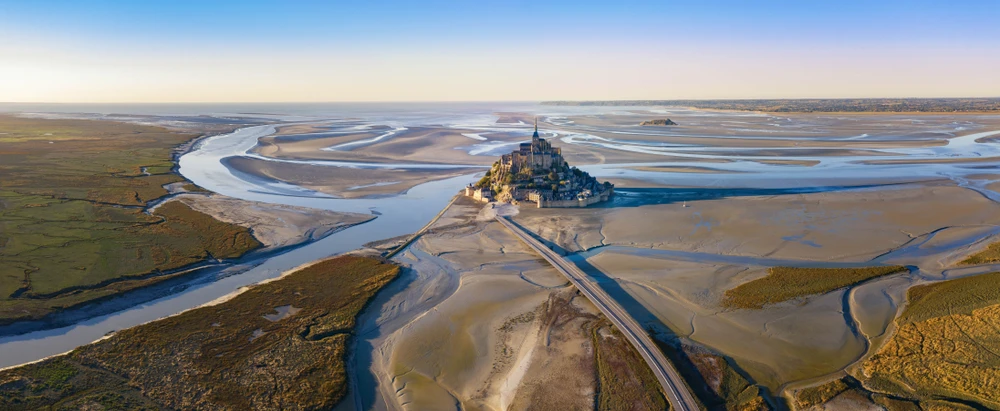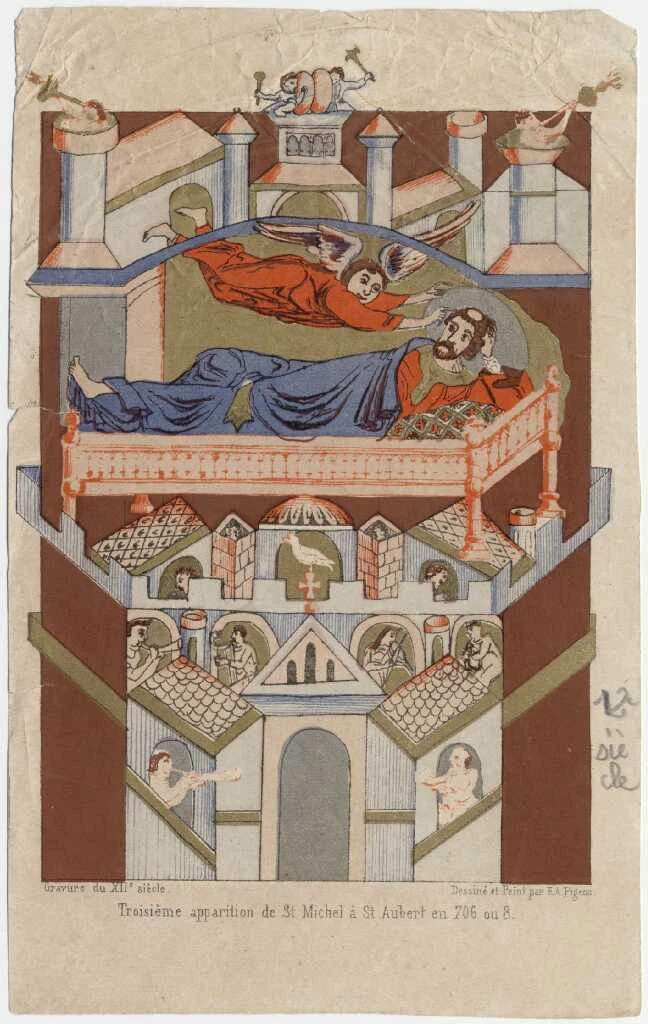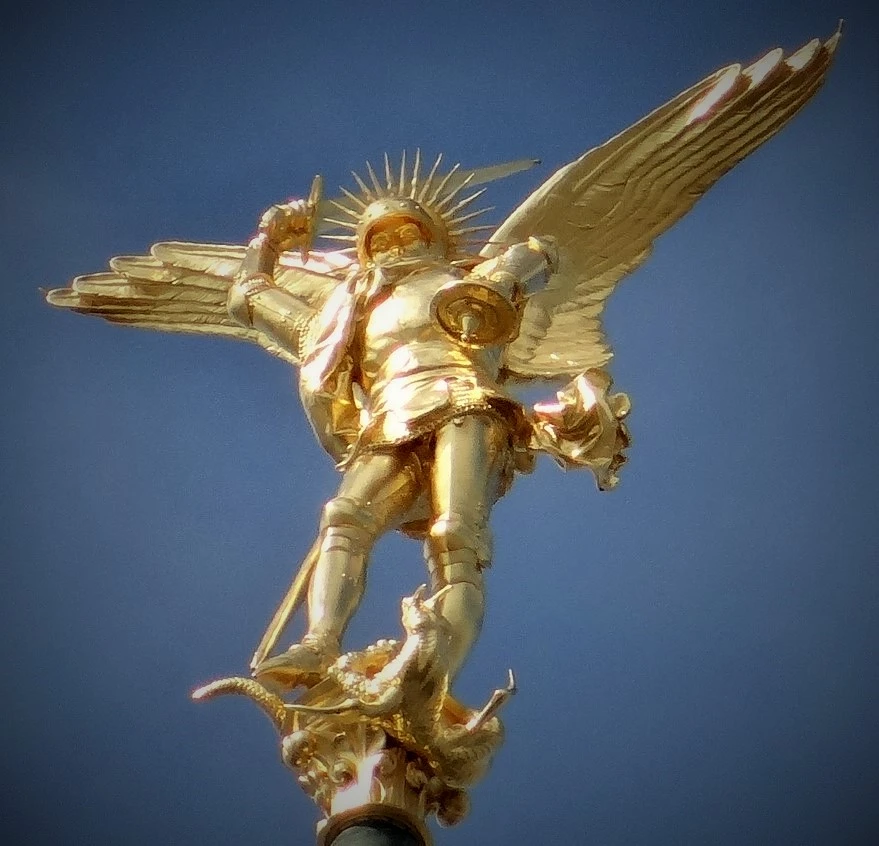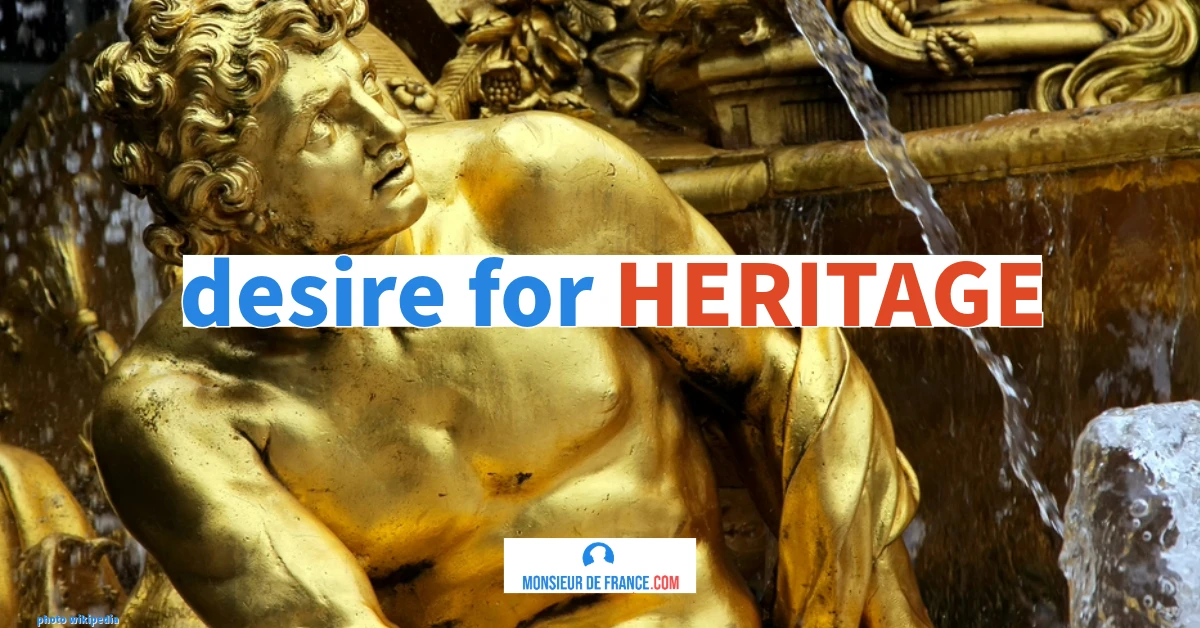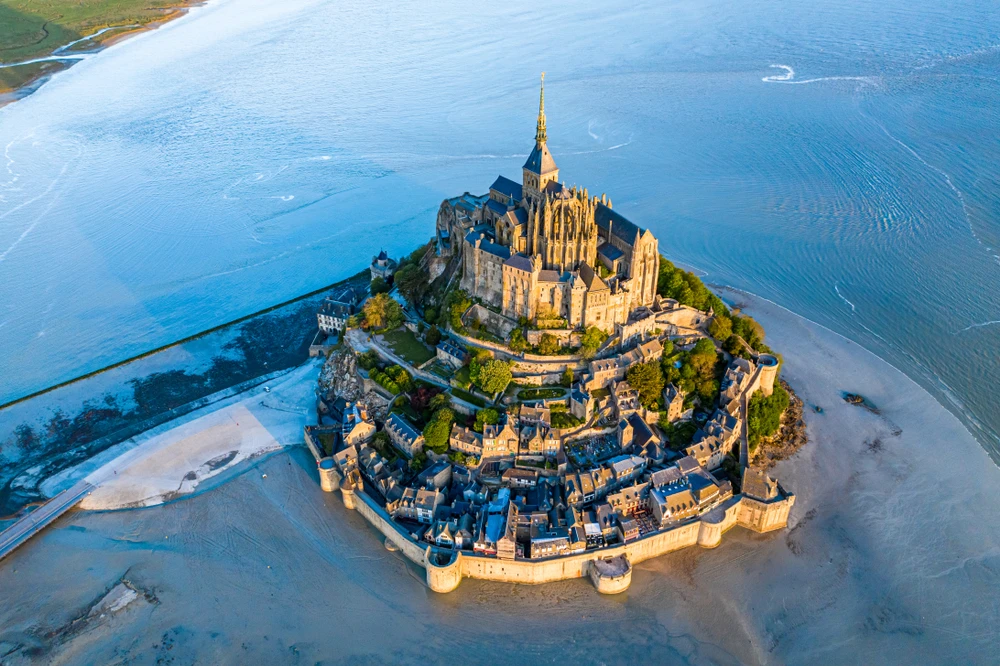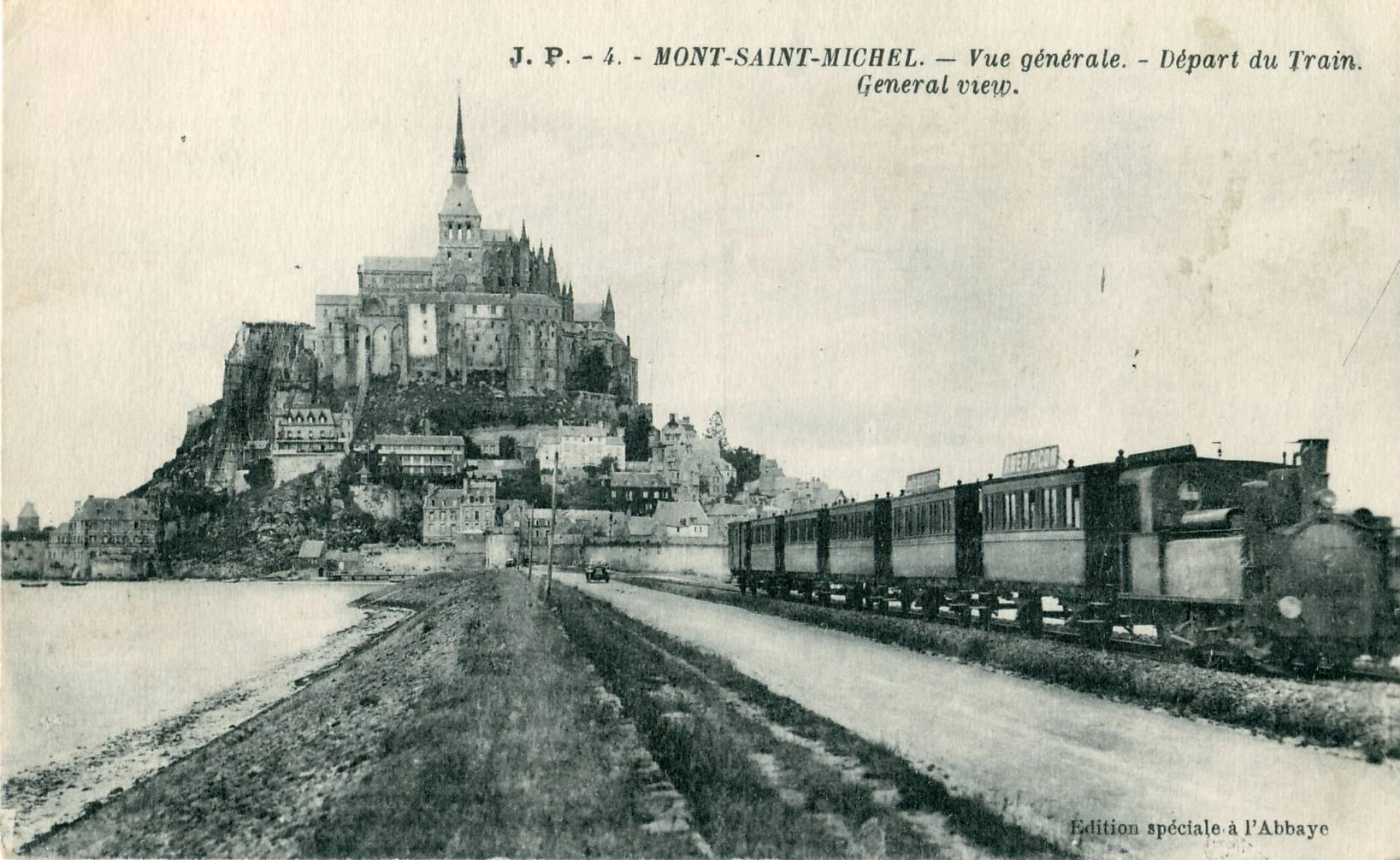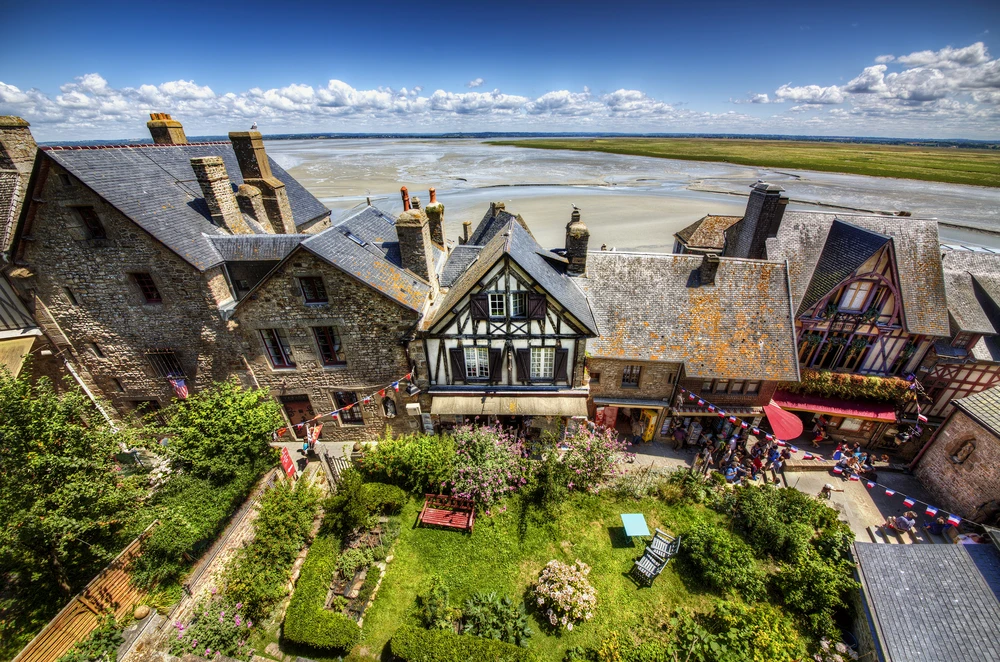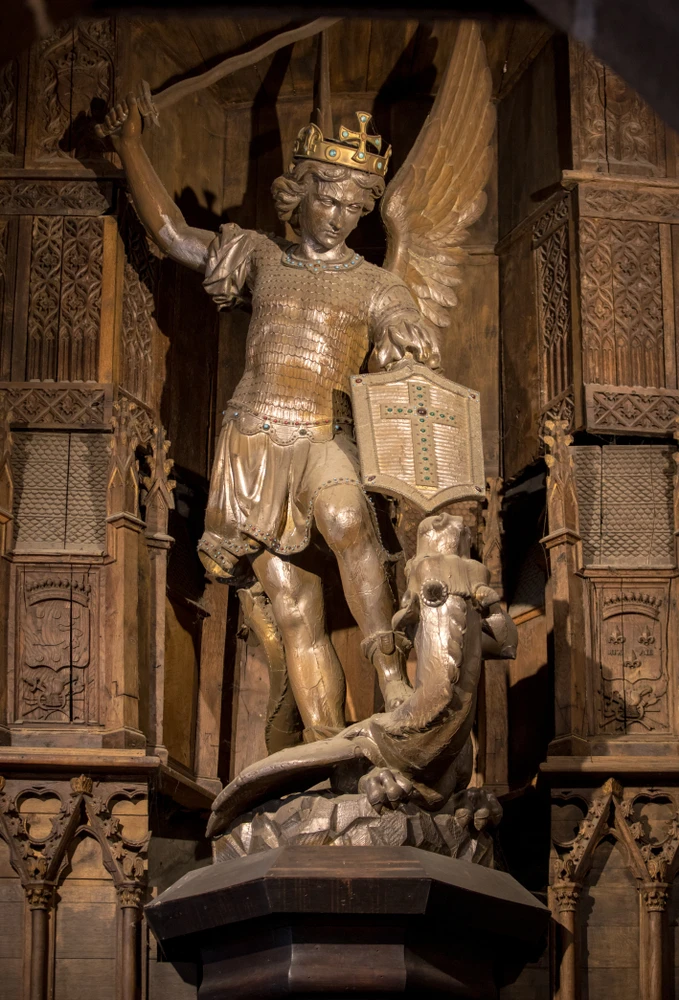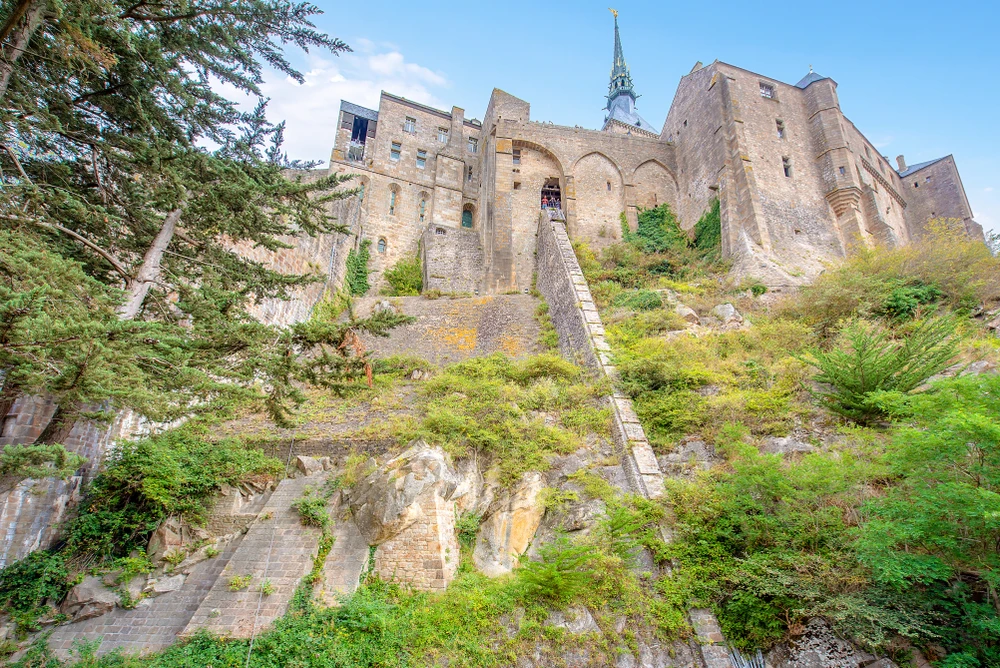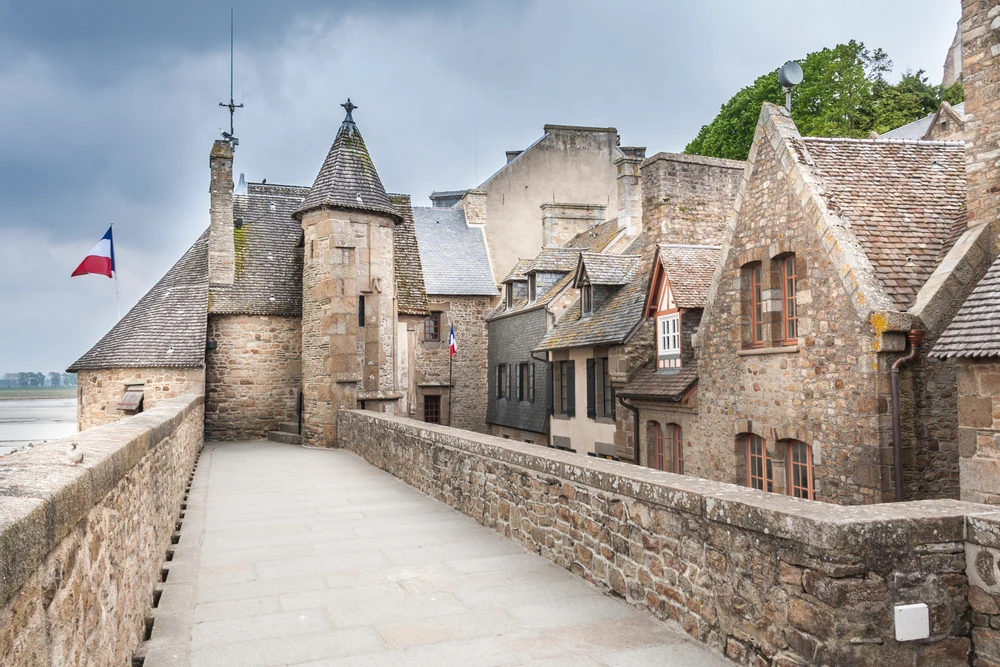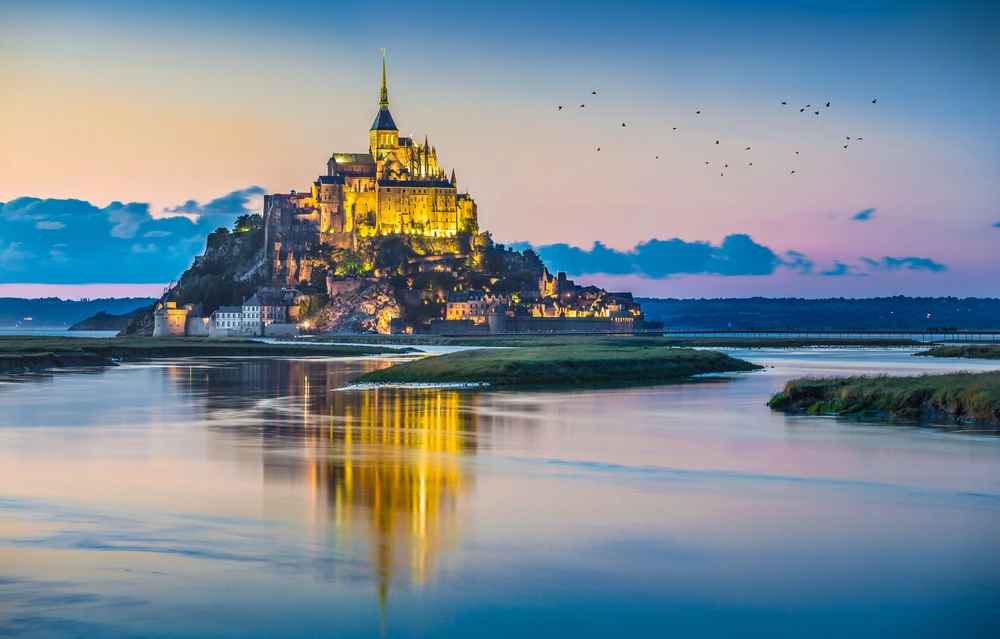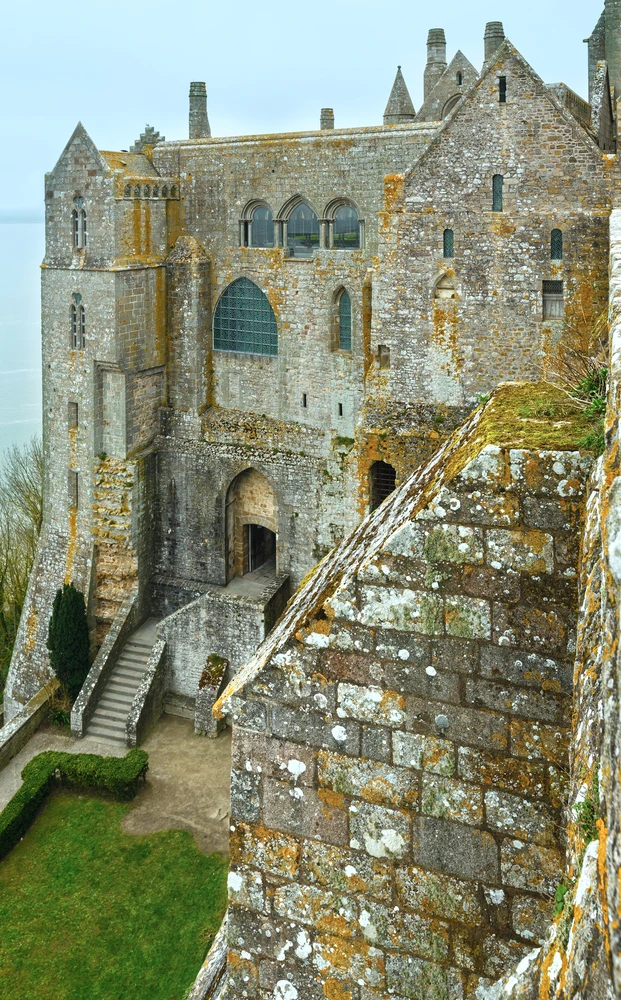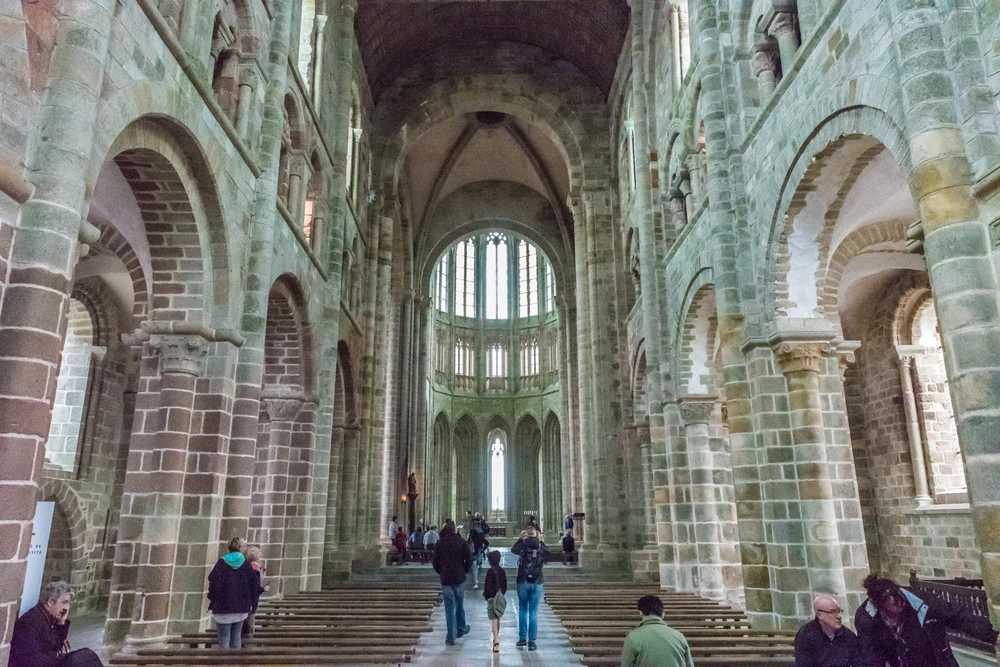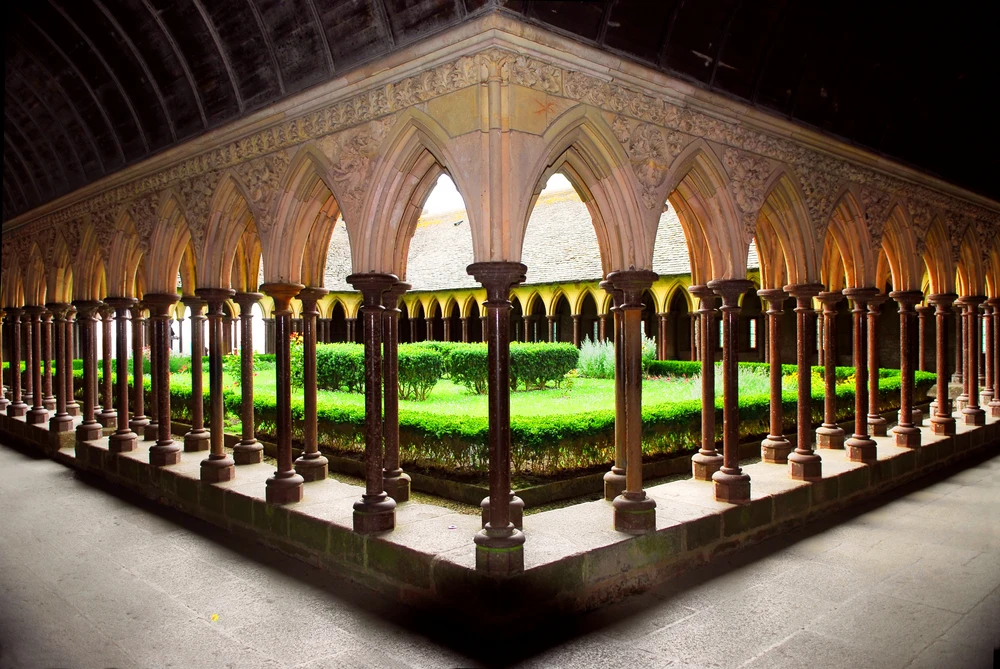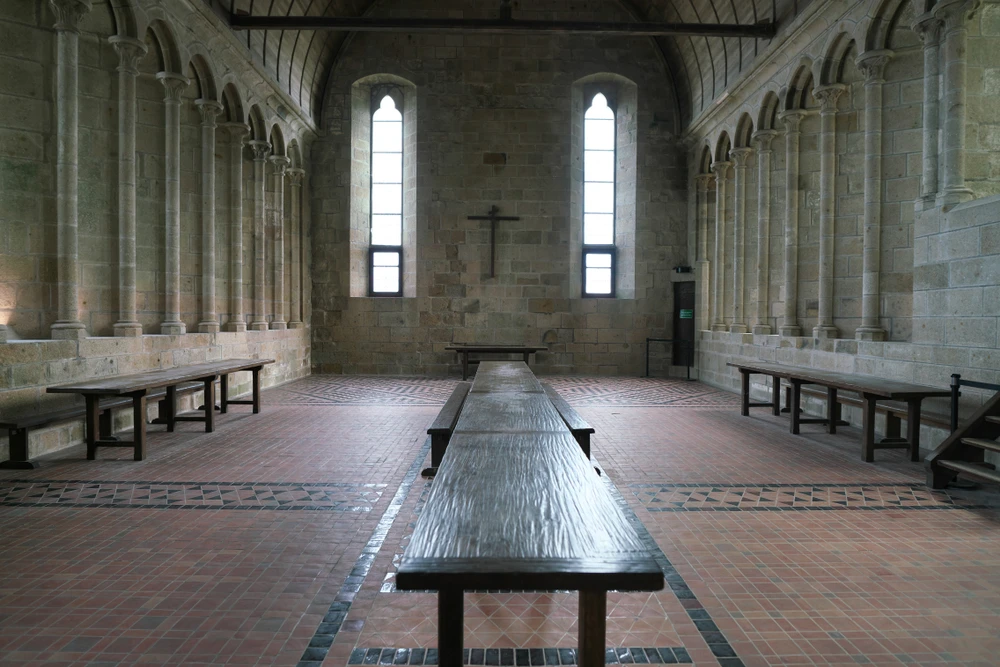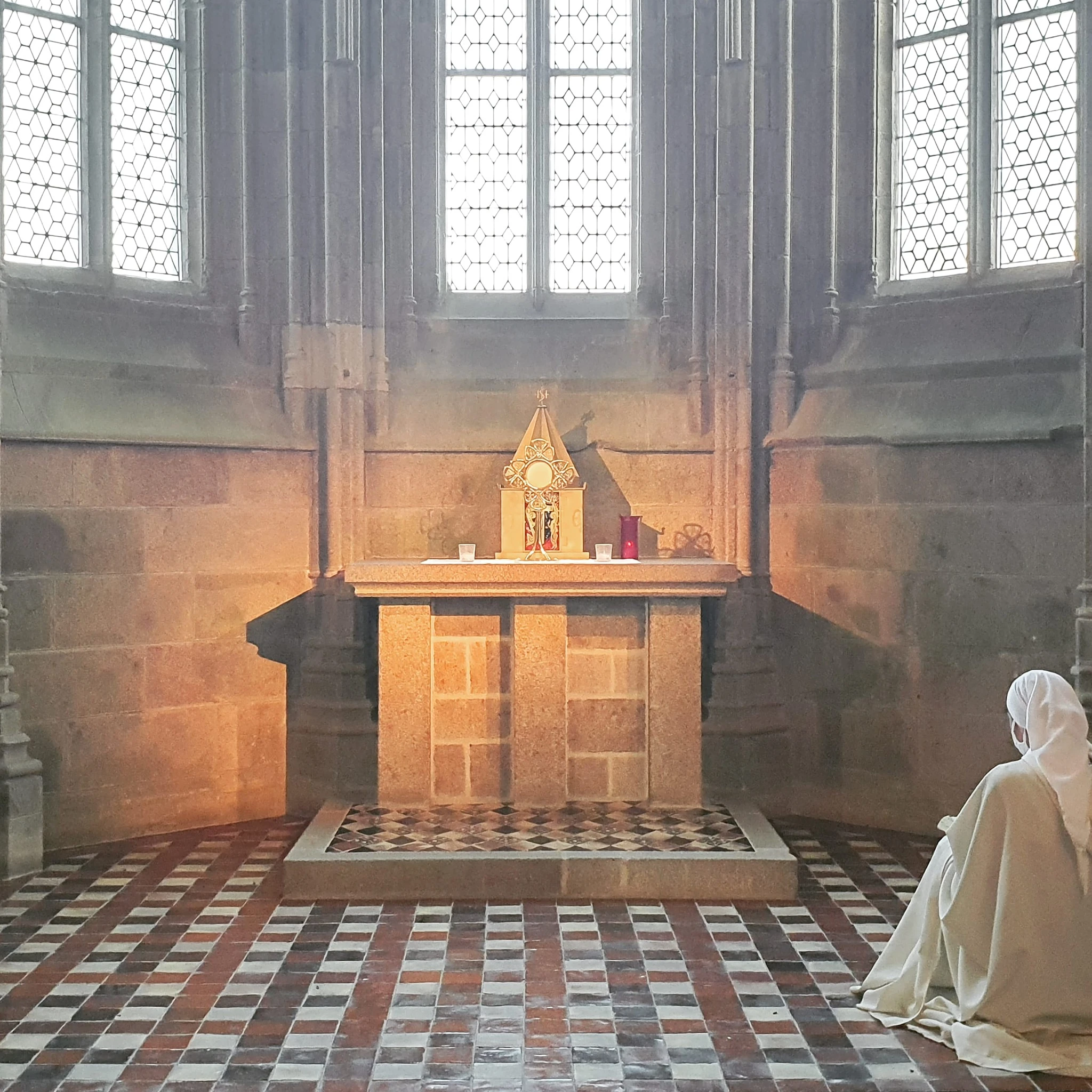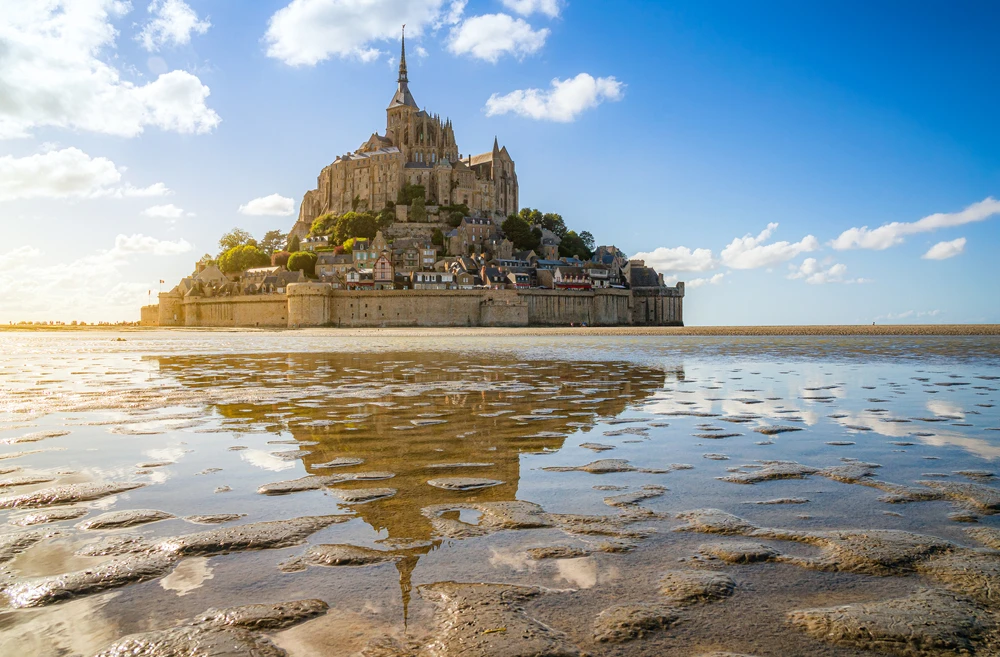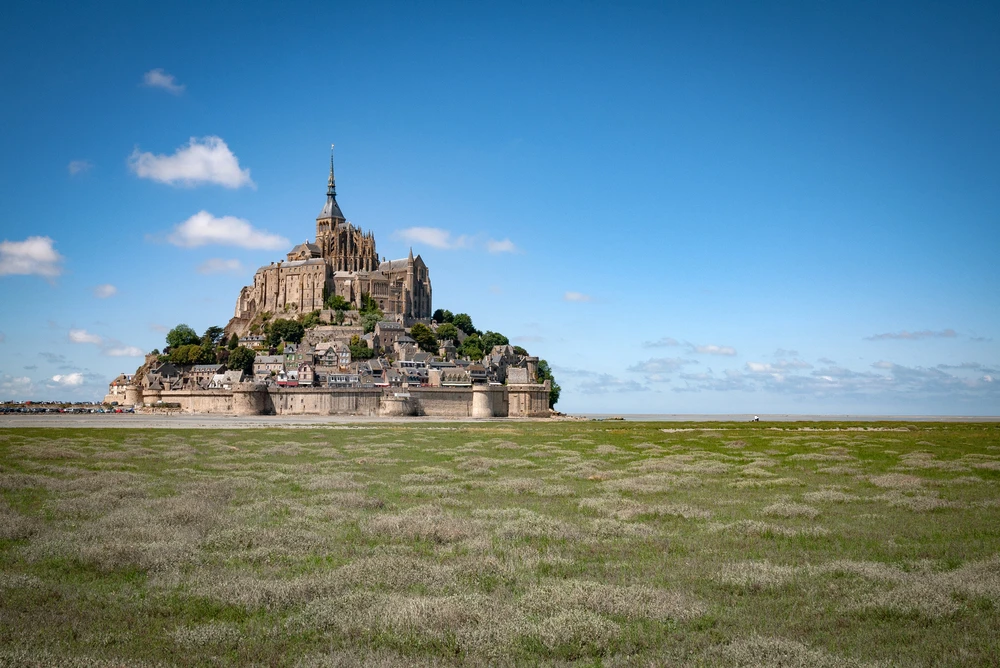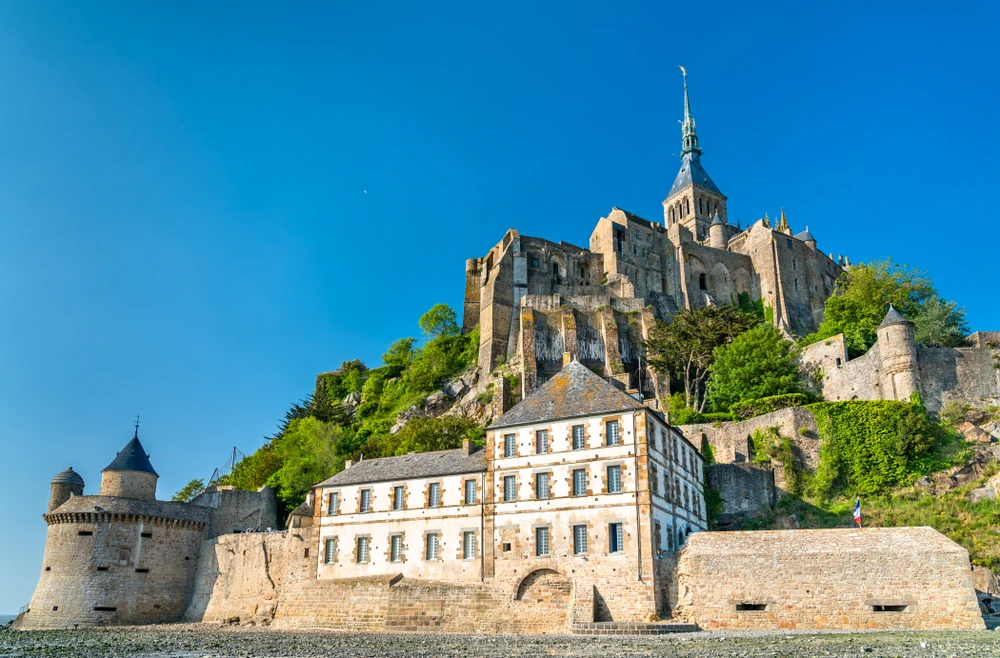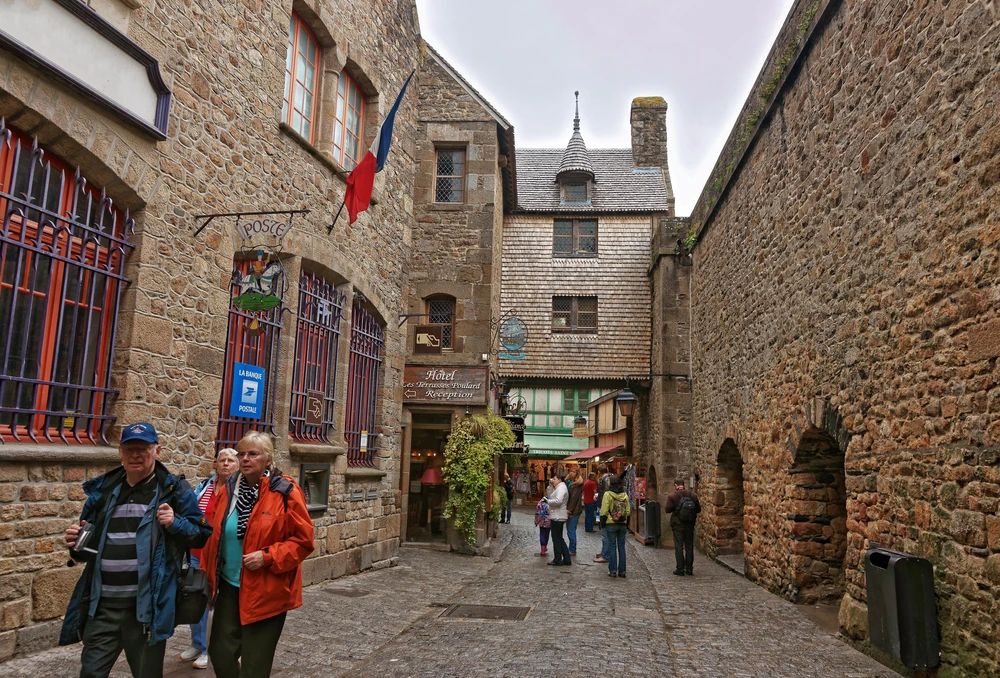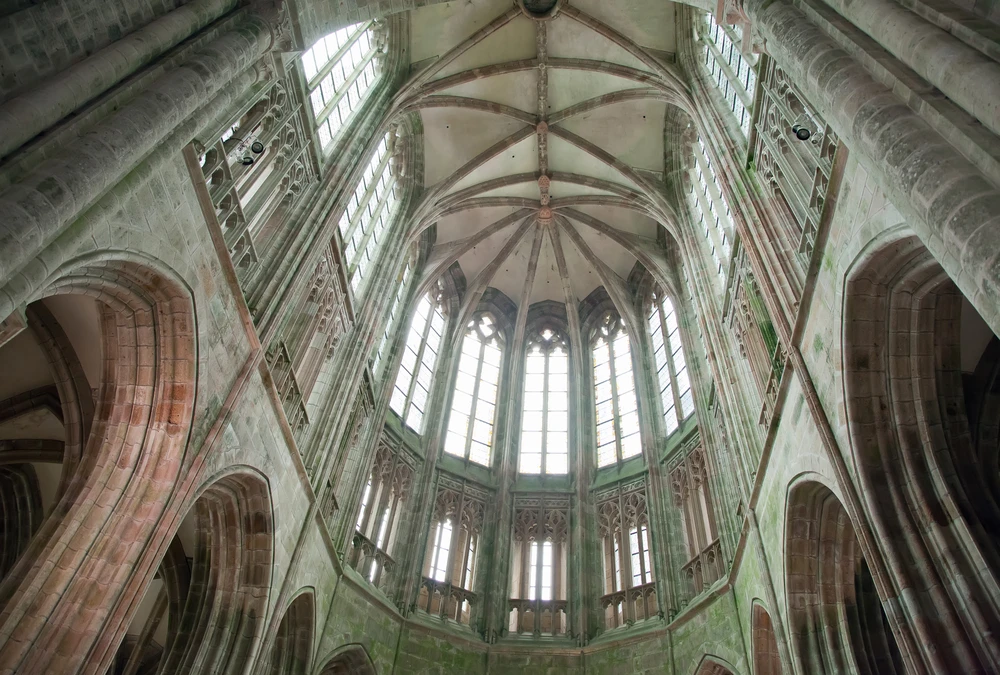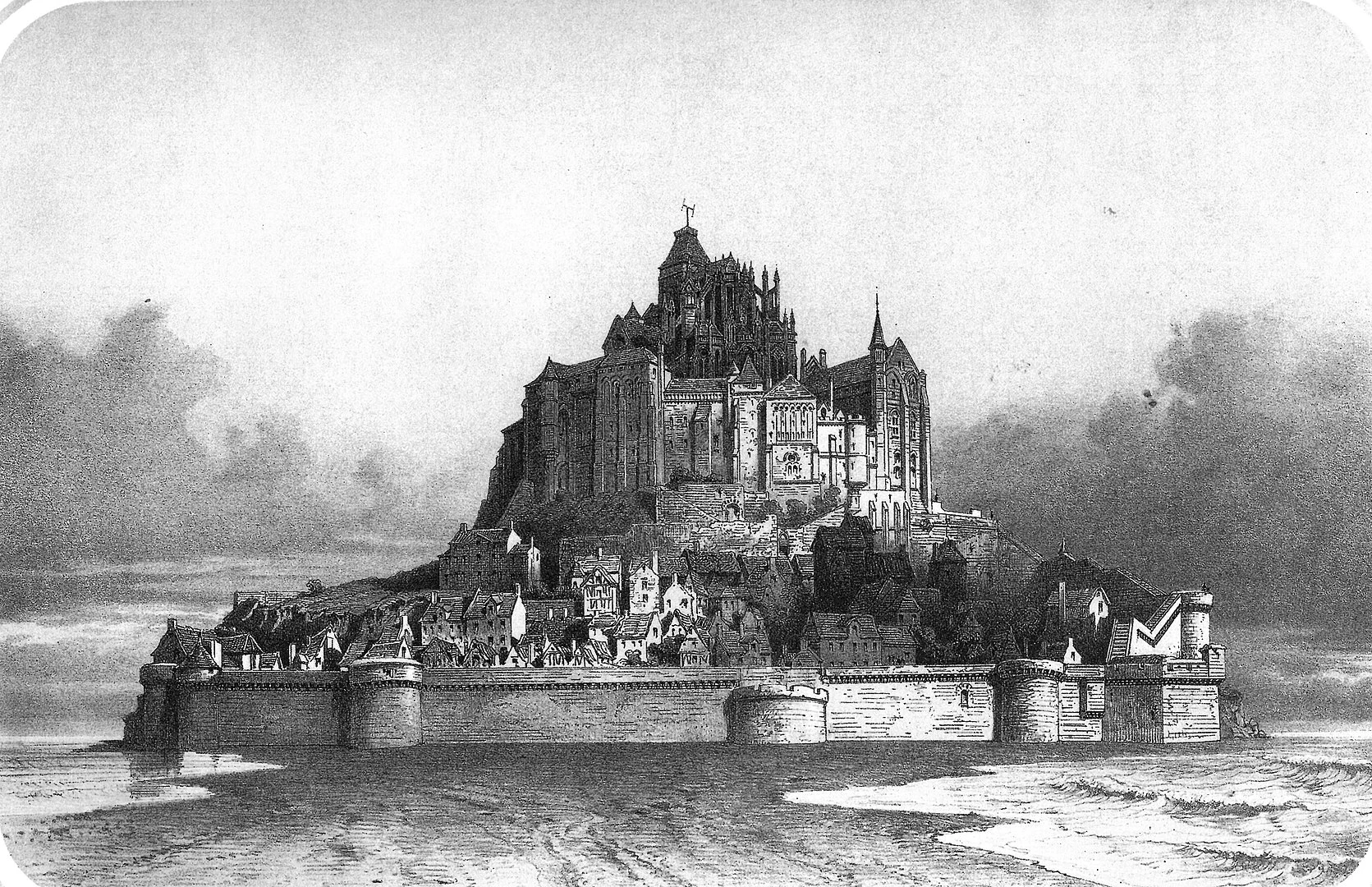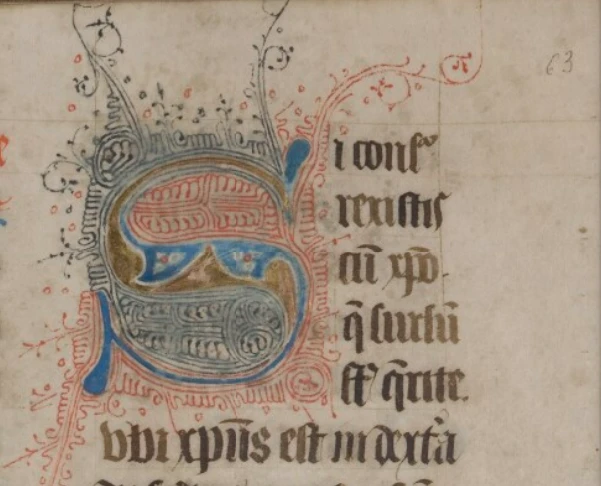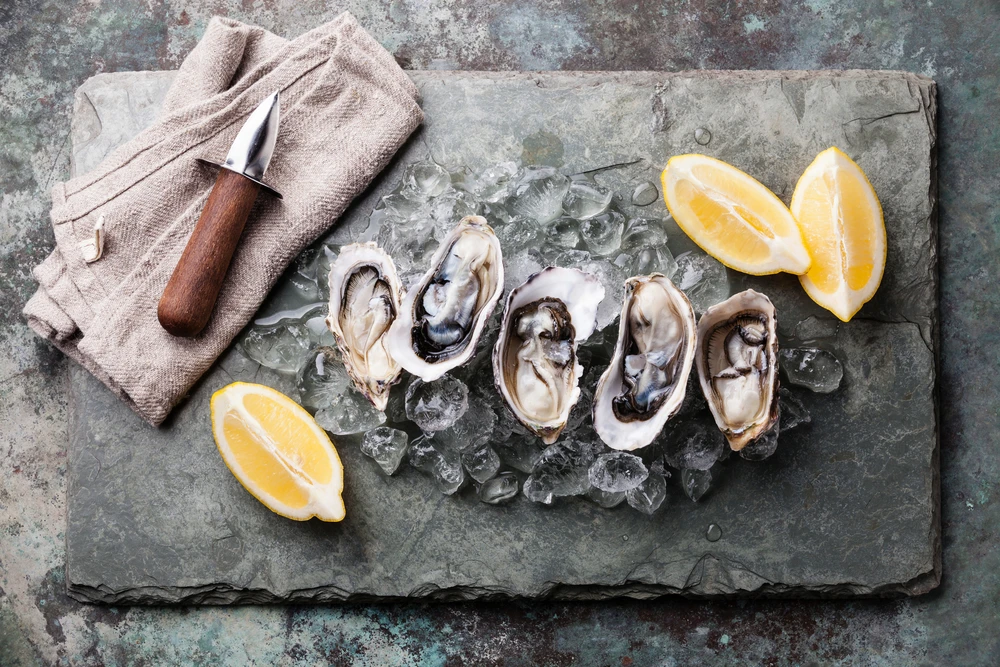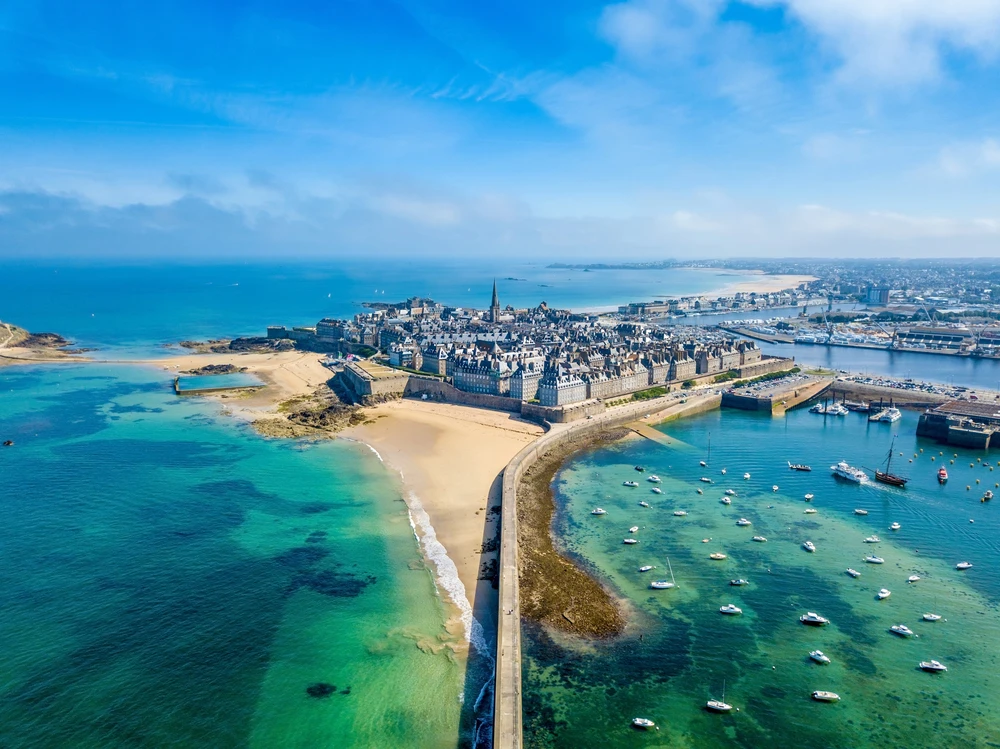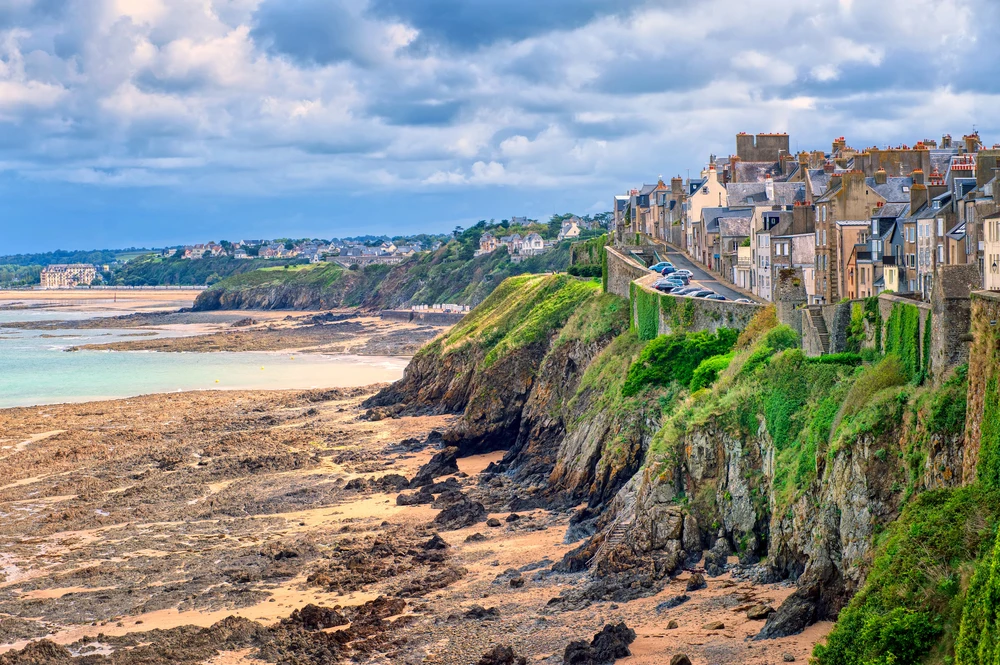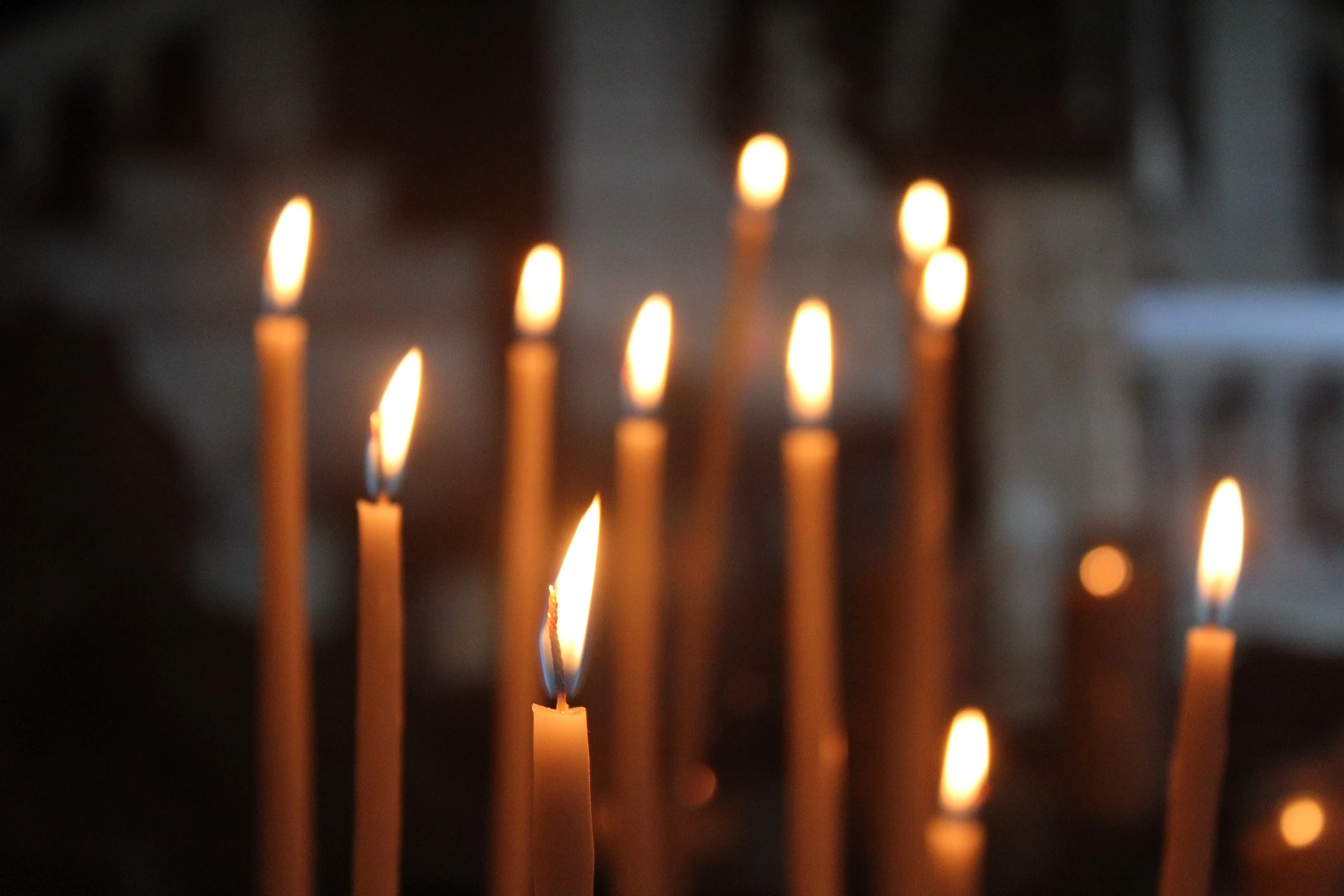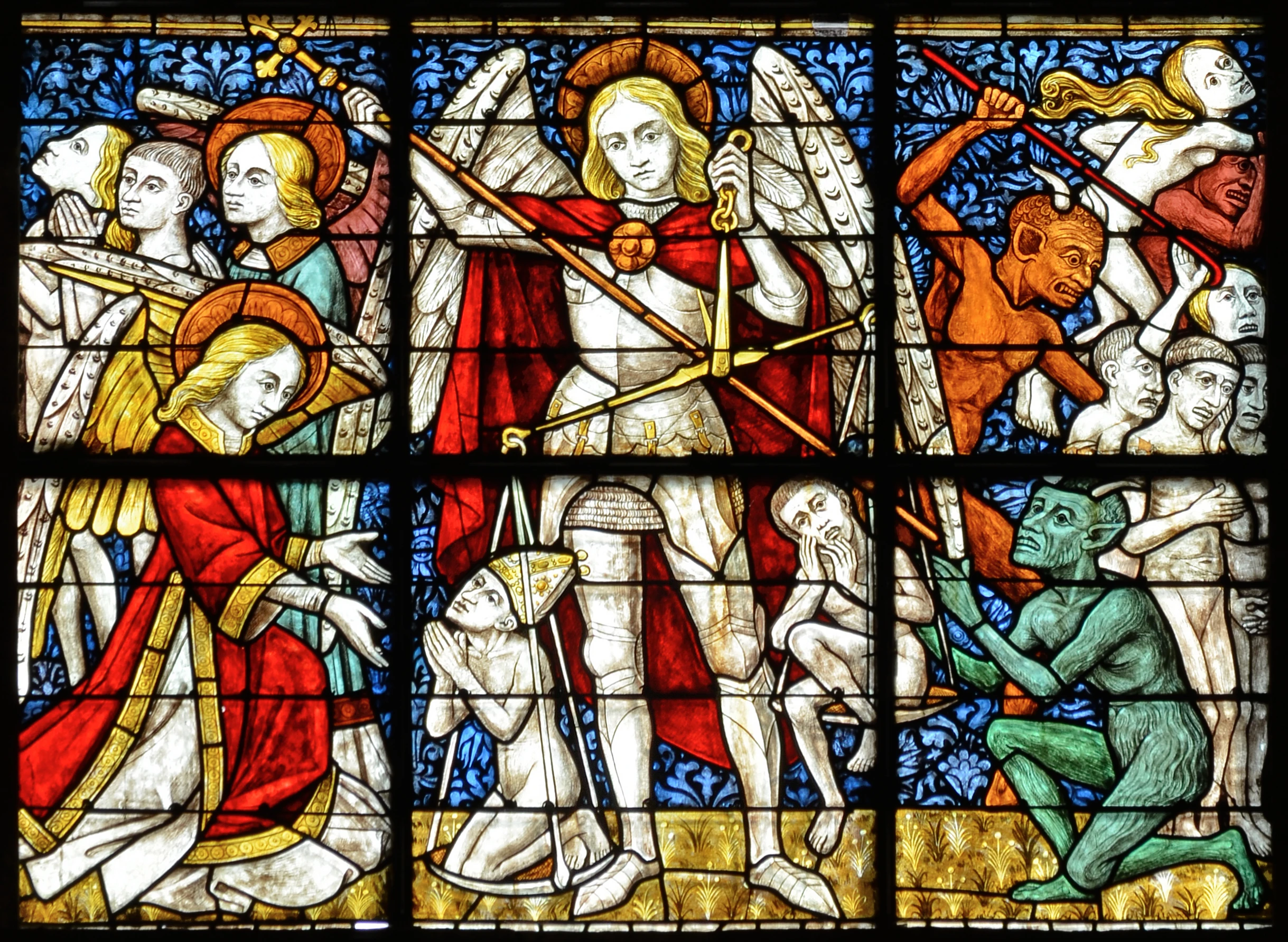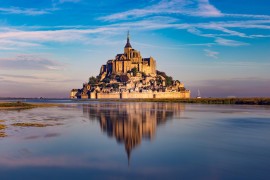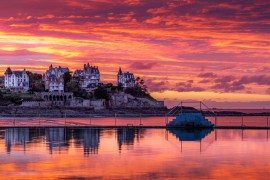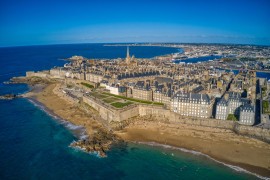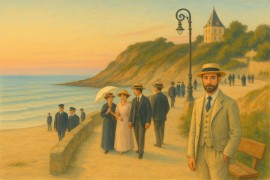Mont-Saint-Michel, a special place
Just a glimpse of its silhouette is enough to understand: le Mont-Saint-Michel is not a place like the others. This small mountain crowned by an abbey emerges from the bay like a mirage. As you approach via the long footbridge, the offshore wind, the smell of salt and the cries of seagulls remind you that we're here in the realm of the elements.
The Mont Saint Michel seen from the air: you can clearly see the bay and its sandbanks and a little further on, in green, the salt meadows. On the left, the river that flows past is called the Couesnon and marks the border between Normandy and Brittany. Le Mont, on the right, is in Normandy. Photo chosen by monsieurdefrance.fr : Jrossphoto/Shutterstock.com
A sanctuary for over a thousand years
According to tradition, the Archangel Michael appeared in a dream to Bishop Aubert of Avranches in 708, ordering him to erect a sanctuary "on Mont Tombe" (the name of Mont Saint Michel at the time). The bishop obeyed, and the rock soon became a major pilgrimage site. Over the centuries, Benedictine monks built a breathtaking abbey where Gothic architecture blends with granite.
Saint Aubert's dream / Archives de la Manche;
A French symbol
A fortress in the Middle Ages, le Mont-Saint-Michel resisted all English attacks during the Hundred Years' War. Transformed into a prison during the Revolution, it once again became a spiritual place in the XIXᵉ century before being listed as a historic monument in 1874. Since 1979, it has been listed as a UNESCO World Heritage Site, in recognition of its historical and landscape importance.
The archangel Saint Michael by Emmanuel FREMIET (1899). He strikes down the dragon lying at his feet. Photo chosen by Monsieurdefrance.fr: Ibex73, CC BY-SA 4.0 <https://creativecommons.org/licenses/by-sa/4.0>, via Wikimedia Commons
A sensory experience
When the tide rises, the Mont is cut off from the mainland: the spectacle is breathtaking. The water gradually surrounds the ramparts, the reflections change, the tourists fall silent for a moment. The site lives to the rhythm of the light and the wind. It's this breathing that gives it its charm: here, you feel France in its mystical, maritime dimension.
Preparing your visit
Before arriving, you need to anticipate: the success of a day depends on the time chosen, the tide and practical organization.
Le Mont Saint Michel vu du ciel: Photo chosen by monsieurdefrance.fr: shutterstock
Choosing the right season
Mont-Saint-Michel can be visited all year round, but not in the same way.
-
Spring: mild temperatures, spectacular tides, flowers in the bay.
-
Summer: long days, lively, but busy.
-
Autumn: gorgeous colors and a quieter mood.
-
Winter: magical light and almost monastic solitude.
👉 The golden hours for photography are early morning (8am - 9am) and late afternoon (5pm - 6pm).
Access and parking
Access by car is via the D976, which leads to the large parking lots on the mainland. From here, a free shuttle bus "Le Passeur" runs to the Mont esplanade in ten minutes. The parking lots are fee-paying (around €15 a day), open 24 hours a day, with special zones for motorhomes and bicycles.
🚶♀️ The more courageous can walk the 2.5 km along the footbridge to enjoy the view over the bay.
You used to be able to take the train to Mont Saint Michel... It was the beginning of the 20th century / Photo selected by monsieurdefrance.fr Scan by Claude Shoshany - Personal collection, Public domain / Wikipedia
Coming by train or bus
From Paris-Montparnasse, Pontorson is reached by TGV via Rennes (3 hr 30 min. journey). Regular shuttles then run to Le Mont.
From Rennes, a direct bus leaves every morning (1 hr 20).
From Caen or Saint-Malo, allow around 1 hr 30 by car.
Where to stay if you want to stay overnight
-
Sur le Mont: crazy charm but rare and expensive rooms.
-
Pontorson: hotels and B&Bs 8 km away.
-
Avranches or Beauvoir: very convenient for enjoying a view of the illuminated Mont in the evening.
Getting ready
Always dress rather warmly, the wind is strong/ Photo chosen by monsieur de France: depositphotos
Please plan ahead:
-
Comfortable shoes: cobblestones are slippery.
-
Wind and rain gear: unpredictable marine climate.
-
Charged camera: the light changes constantly.
-
And if you're coming with children, prefer the baby carrier: there are plenty of steps.
The ideal itinerary for a day trip to Mont-Saint-Michel
Mont-Saint-Michel is best discovered on foot: every step counts. To make the most of this unique site, it's best to follow a progressive itinerary: start with the ascent to the abbey, then gently descend and stroll along the ramparts.
Morning (8:30am - 11am): climb to the abbey
Some Montois houses. Photo chosen by Monsieurdefrance.Fr: Rolf E. Staerk/shutterstock
Arriving at the footbridge is an unforgettable moment: the Mont rises up before you, changing hue with every step. Slowly cross over, let the magic win you over.
The main entrance leads to the Grande Rue, lined with medieval houses, wrought-iron signs and boutiques. Even if it's a busy street, just step aside into an alleyway and you'll find the silence of the old stones.
The climb up to the abbey takes around twenty minutes. On the way, the staircases offer magnificent views of the bay.
Saint Michel, dans l'église du Mont. Photo chosen by Monsieurdefrance.Fr: wjarek/shutterstock
Noon (11 am - 1 pm): visit the abbey
The spiritual heart of Le Mont is her: the Benedictine abbey crowning the rock. Founded in the Xᵉ century, enlarged in the XIIᵉ and XIIIᵉ, it bears witness to extraordinary architectural craftsmanship.
Entrance is via the western terrace, from where you overlook the entire bay. Inside, one discovers successively:
-
The abbey church, sober and luminous, perched 80 meters above sea level.
-
The cloister, a masterpiece of Gothic lightness.
-
The monks' refectory, with its slender vaults.
-
The hosts' hall and the knights' hall, more austere.
Allow 1 h 30 to 2 h for the visit. Tickets can be purchased on site or at abbaye-mont-saint-michel.fr; book in advance to avoid the queue.
On leaving, the terrace offers a sublime view: on a clear day, you can see Cancale and Granville.
The Abbey seen from below. Photo chosen by Monsieurdefrancefr: Nick Brundle Photography/Shutterstock.com
Lunch break (1:00 p.m. – 2:00 p.m.)
For a quick break, get out of the crowds and sit on the ramparts: the scenery is worth all the restaurants.
You'll find plenty to eat on the Mont: crêpes, galettes, omelettes or produce from the bay. You're at a junction between two VERY gourmet regions: Brittany (buckwheat galettes) and Normandy (cream, butter...).
Afternoon (2 pm - 5 pm): strolling the ramparts
The walk back down the side streets is full of surprises: fortified gates, hanging gardens, ancient sculptures.
Take the chemin des remparts, which circles the village: it offers a succession of spectacular views over the bay and the mainland.
As you pass, you'll catch a glimpse of the statue of Saint Michel slaying the dragon, shining from the top of the abbey.
Les remparts du Mont Saint Michel sont accésibles Photo chosen by Monsieurdefrance.Fr: Photomario/shutterstock
Late afternoon (5 pm - 7 pm): golden light
This is undoubtedly the most beautiful moment. As the sun declines, Mont-Saint-Michel turns golden, then copper.
The bay slowly empties, the last visitors drifting away.
From the footbridge, take time to watch the water reflect off the walls: a suspended moment that sums up all the poetry of the place.
Mont Saint Michel at dusk / Photo chosen by Monsieur de France: depositphotos
Visit Mont-Saint-Michel Abbey: a masterpiece perched between sea and sky
It's the spiritual heart of Le Mont, the jewel that has dominated the bay for over a thousand years. Built on granite rock, the Benedictine abbey seems to float between earth and cloud: an architectural feat where every stone tells of the faith and ingenuity of medieval monks.
The walls of the Benedictine abbey seen from the outside (you can see the outside of the suspended cloister) Photo chosen by Monsieurdefrance.fr: Landscape Nature Photo/Shutterstock.com
An ascent through the centuries
Entrance is via the terrasse de l'Ouest, from which you can enjoy a breathtaking panorama of the bay. At your feet, the silvery sands, in the distance the Breton coastline: it's easy to understand why pilgrims saw this as a foretaste of paradise.
The abbey is visited by following an ascending route: as you climb the stairs, you pass through increasingly luminous rooms, symbolizing the soul's ascent to God.
The abbey church, the "Wonder" of the Mont
The interior of the Abbey church. The columns on the sides are 1000 years old. The choir, at the back, was built in the 15th century. Photo chosen by Monsieurdefrance.fr: Takashi Images/Shutterstock.com
Built between the XIᵉ and XVIᵉ centuries, the abbey church caps the rock almost 80 meters above sea level. Its flamboyant Gothic choir, rebuilt after a 15th-century collapse, is bathed in golden light. The slender arches merge into the vault, supported by immense buttresses visible from the bay. Outside, the slate-covered spire bears the gold-leafed statue of the Archangel Michael, which can be seen glittering for miles around.
The cloister: a miracle of balance
The suspended cloister of Mont Saint Michel with its delightful offbeat columns and acanthus leaf sculptures. Photo chosen by Monsieurdefrance.fr: Elena Elisseeva/Shutterstock.com
Higher still, the cloister is undoubtedly the most poetic part of the abbey. Suspended between sky and sea, it seems to float in the light. Its slender, twisted columns form harmonious galleries: a place of absolute silence where monks meditated while contemplating the horizon. From here, you can sometimes hear the cry of seagulls and the breath of the wind: a contrast between peace and immensity.
The refectory and monks' halls
Next comes the refectory, a vast vaulted room where monks ate their meals in silence, punctuated by the reading of the Holy Scriptures. The acoustics here are striking: a whisper is enough to fill the room.
The guests' hall, more sumptuous, welcomed distinguished pilgrims; the knights' hall, sober and majestic, testifies to the skill of Norman builders. Each pillar, each stone, tells the story of a thousand years of history.
The refectory. You can't see the windows on the sides, which are hidden by the columns. Photo chosen by Monsieurdefrance.fr: Khun Ta/Shutterstock.com
The abbey dwelling and terraces
The tour ends on the terrace of the logis abbatial, from where the view over the bay is spectacular. At equinox tides, the water rises to eye level, encircling the Mont in a silvery sheen.
On a clear day, Granville and Cancale can be made out; in fog, the rock seems to emerge from a sea of clouds.
A timeless atmosphere
To visit the abbey is to walk in the footsteps of medieval pilgrims. The silence, the half-light of the staircases, the light filtering through the stained glass windows: everything contributes to an impression of eternity. It's a place of stone and sky, both fortress and prayer.
💡 Practical tip: allow at least 1 h 30 to 2 h for the full tour. Guided tours are offered by the Centre des Monuments Nationaux, as well as summer night tours, where music and light effects transform the experience into a true inner journey.
Le Mont Saint Michel is still a place of prayer / Photo chosen by Monsieurdefrance.Com: Jérôme Prod'homme
Understanding the tides at Mont-Saint-Michel
The Bay of Mont-Saint-Michel is one of the most impressive in Europe. The sea can come up here at the speed of a galloping horse, so the saying goes.
Why are these tides so strong?
They result from the funnel shape of the bay and the amplitude between low and high water: sometimes over 14 meters.
Coefficients in excess of 110 completely surround Mont, making it an island once again.
Always beware of the sand in the bay of Mont Saint Michel, it has swallowed up many an unwary person.. Photo chosen by Monsieurdefrance Nyokki/shutterstock
When and where to observe them?
Check the official SHOM schedules: they vary daily.
From the footbridge, you can see the water progressing rapidly.
For a unique experience, take a guided crossing of the bay: you walk barefoot on the sand, accompanied by licensed guides.
But beware: it's dangerous to venture out alone - quicksand can surprise even regulars.
A fragile ecosystem
In addition to the sea, the bay is home to remarkable wildlife: salt meadow sheep, herons, egrets, sometimes seals. Each tide shapes this shifting landscape, between land and water, where Mont-Saint-Michel retains its thousand-year-old majesty.
The salt meadow lamb of Mont Saint Michel is very famous and it can freely go in the herbus of the bay of Mont Saint Michel like this one / Photo chosen by Monsieur de France: depositphotos
Tips for avoiding the crowds and enjoying Mont-Saint-Michel
We often talk about the beauty of Mont-Saint-Michel, but we sometimes forget about its popularity: over two million visitors a year! To enjoy this unique place without the crowds, the secret lies in timing and less-frequented itineraries.
1. Come early... or late
The parking lots open at 7 a.m., allowing you to arrive before the first shuttle bus. This is the magic hour: the mist still hangs over the bay, the shutters open slowly and the cobblestones are deserted.
Another option: come in the late afternoon. After 5 p.m., the buses leave and the Mont regains its soul. The alleyways empty out, the light softens, ideal for photos.
Le Mont Saint Michel is also a fortress (impregnable to the English during a 30-year siege). Photo chosen by Monsieurdefrance.fr: Leonid Andronov/Shutterstock.com
2. Choose the right season
-
November to March: the most peaceful season, despite the wind and rain.
-
April-May and September-October: perfect balance between mild weather and reasonable crowds.
-
Summer: favor mornings and late afternoons, avoid weekends.
Le Mont Saint Michel is less visited in winter and on weekdays outside weekends in the summer / Photo chosen by monsieurdefrance.com: depositphotos
3. Explore secret corners
Coming down from the abbey, leave the Grande Rue to take la venelle du Nord or le chemin des Fanils: little passages where time seems to stand still.
From here, you'll have the most beautiful views over the bay, with no one around.
4. Astuce photo
The best angle for photographing Mont? From the passerelle at sunset, or from the Beauvoir salt meadows. High tide gives superb reflections, low tide reveals the golden sands.
Practical information for a successful visit to Mont Saint Michel
Abbey opening times
-
1ᵉʳ May - August 31: 9 am - 7 pm (last access: 6 pm).
-
1ᵉʳ September - April 30: 9:30 am - 6 pm (last access: 5 pm).
Closed on January 1ᵉʳ, May 1ᵉʳ and December 25.
The Gothic choir of the abbey church of Mont Saint Michel Photo chosen by Monsieurdefrance.Fr: Daniela Migliorisi/shutterstock
Tariff (2025)
-
Plein tarif : 13 €
-
Reduced : 10 €
-
Free for EU citizens under 26.
(these prices are indicative and do not commit Monsieur de France, go to the official website).
Access from major cities
-
Paris : 360 km, approx. 4 h by car or 3 h 30 by TGV to Pontorson + shuttle.
-
Rennes : 90 km, 1 h 20 by car.
-
Caen : 130 km, 1 h 45.
-
Saint-Malo: 55 km, 1 hour.
Mont Saint Michel drawn in 1856 by Thomas Drake;
Parking
Parking lots are located 2.5 km from the Mont, well signposted. Daily rates, specific zones for motorcycles, campers and buses.
Accessibility
The shuttle buses and footbridge are wheelchair accessible right up to the foot of the mountain. Inside the village and abbey, however, there are many steps.
Around Mont-Saint-Michel
Mont-Saint-Michel is a world unto itself, but its surroundings are also worth a detour. In less than an hour's drive, you'll discover other treasures of Normandy and Brittany, often linked to its history or its bay.
Avranches, the city of manuscripts
A letter from one of the Mont Saint Michel manuscripts posted on the Mont Saint Michel virtual library;
Just 25 km away, Avranches is home to the Scriptorial, a fascinating museum dedicated to the manuscripts of Mont-Saint-Michel. Here, copyist monks recopied the Bible and ancient texts with meticulous artistry. 👉 A perfect stop-off point for understanding how the Mont influenced the whole of medieval Christendom.
Cancale and its oysters
Some oysters, speciality of Cancale Photo chosen by Monsieurdefrance.Com : Natalia Lisovskaya / Shutterstock.Com
On the Breton side, 45 minutes from Le Mont, Cancale opens onto the sea with its lively port. Renowned since Louis XIV for its oysters, the town offers superb panoramic views over the bay. At low tide, you can see the oyster beds, and in the distance, the silhouette of Le Mont like a marine mirage.
Saint-Malo, the corsair city
Saint Malo on its rock surrounded by ramparts / Photo chosen by monsieur de France: depositphotos
Just under an hour away, Saint-Malo erects its ramparts facing the Atlantic. Here, you can stroll along the walls, visit the shipowners' houses, and feel the breath of sailors everywhere. On a clear day, you can make out the bay of Mont-Saint-Michel: the sea links the two citadels.
Granville, port and Norman elegance
Just 55 minutes away, Granville is a seaside resort full of charm. Here you can discover the Haute-Ville fortifiée, the musée Christian Dior, and a Belle Époque atmosphere. It's also an excellent departure point for the Chausey Islands, a wild archipelago accessible by boat.
Granville / Photo chosen by Monsieur de France: depositphotos
FAQ: everything you need to know before visiting Mont-Saint-Michel
Is Mont Saint Michel Breton or Norman?
Norman! Built by order of a Norman bishop (Aubert) on the border of the Duchy of Normandy with stones from the Chausey Islands (in Normandy);
How long does it take to visit?
Allow at least half a day to explore the abbey and village, a full day if you're exploring the bay.
Can we visit for free?
Yes, access to the village is free, only entrance to the abbey is chargeable.
When is the highest tide?
The highest tides occur during the full and new moons, often in March and September, with coefficients in excess of 110.
Mont Saint Michel soon became a sanctuary and the object of numerous pilgrimages. Photo chosen by Monsieurdefrance.Fr : Image by Nbyl de Pixabay
Can we sleep on the Mount?
Yes, but you'll need to book well in advance: accommodations are few and far between.
Where to stay to admire the illuminated Mont?
The hotels of Beauvoir, Pontorson and Avranches offer splendid views at night. Moi j'ai un faible pour Saint Jean le Thomas
What's the best time of year to visit?
Spring and autumn combine pleasant weather and reasonable visitor numbers.
Are dogs allowed?
Yes on the footbridge and in the village, no inside the abbey.
Do I need to book the shuttle?
No: it runs continuously and free of charge between the parking lot and the Mont, approximately every 15 minutes.
How many visitors each year?
Nearly 2.5 million people pass through its gates, making it one of the most visited monuments in France.
What's the best time for photos?
At high tide, at sunrise or sunset, when the Mount is reflected in the bay.
Saint Michel weighs souls. Coutances Cathedral (Normandy not far from Mont Saint Michel). 15th-century Last Judgment stained glass. Photo chosen by Monsieurdefrance.fr : Selbymay - Personal work, CC BY-SA 3.0, https://commons.wikimedia.org/
What I liked best about Mont-Saint-Michel
Hard to choose, but the evening silence on the ramparts remains etched in my memory. When the tourists leave, the Mont empties. The wind blows, the light dims, and we hear the bells ringing. You realize that here, for over a thousand years, people have come to seek the same thing: a little eternity.

